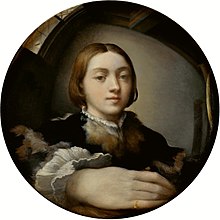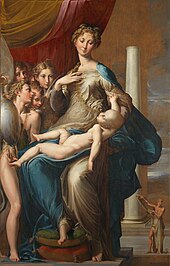Parmigianino
Parmigianino (born January 11, 1503 in Parma , † August 24, 1540 in Casalmaggiore , Parma; actually Girolamo Francesco Maria Mazzola ) was an Italian painter and etcher of Mannerism .
biography
childhood
Francesco Mazzola was born on January 11, 1503, the eighth son of a family of craftsmen and artists. His full name was on the (Latin) baptismal certificate Jeronimus Franciscus Maria filius Philipi de Mazolis . After the early death of his father Filippo (1505), he was raised by his paternal uncles, who encouraged his talent and let him teach natural sciences and music in addition to humanistic subjects.
Parma and Rome (1521–1527)
After a short stay in Viadana , Parmigianino began to work in the Church of San Giovanni around 1521/1522. According to the sources, he is said to have met Antonio da Correggio there on the scaffolding of the dome . From Parmigianino comes u. a. the decoration of the arches of three side chapels. He was later commissioned to paint several parts in the left transept of Parma Cathedral . Despite his youth, he is referred to in the relevant contract as a “Magister”, proof of the respect that was already shown to the young painter.
In the summer of 1524 Parmigianino traveled to Rome . He brings his famous self-portrait in the convex mirror with him and is immediately celebrated at court as the new Raphael . Pope Clement VII promises him the decoration of the Sala dei Pontefici. A few smaller works have come down to us from this period; Parmigianino seemed to have devoted himself primarily to drawings and studies. The sack of Rome in 1527 interrupted Parmigianino's stay in Rome.
Bologna (1527-1530)
In the years after his return from Rome, he spends more time in Bologna, which is relatively close (less than 100 kilometers away) to his hometown Parma. The time in Bologna is very productive. Parmigianino received many orders, but these did not lead to wider recognition. Even the Allegorical Portrait of Charles V from 1530 apparently had no effect on the sitter. His collaboration with the engraver Antonio da Trento also fell during the Bolognese period, who perhaps, due to upsets in the personal relationship between the two, robbed him of all of his engravings, woodcuts and, above all, drawings that he never saw again.
Parma (1531-1540)
After his return to Parma, around 1530/1531 Parmigianino undertook to paint the apse and the barrel vault of the newly built church of Santa Maria della Steccata. Since then he has been referred to in the documents as "Dominus", a sign of his rise in the social hierarchy.
One of the private commissions that Parmigianino accepted during this period was the so-called Madonna with the long neck , which was later painted for a family chapel . In 1535 Parmigianino was able to resume the long-delayed work on painting the steccata. At least the barrel vault was completed by 1538, but due to further delays in the decoration of the apse, the order was finally withdrawn from him in December 1539 by the brotherhood of the Steccata. Giulio Romano was hired in his place, but he resigned his promise in March 1540, as this work would be beyond his strength. Finally, Michelangelo Anselmi takes over the job.
In his refuge in Casalmaggiore , Parmigianino died in 1540 at the age of 37 of river fever (malaria). There he was buried in the cemetery of the Chiesa dei 'Frati dei Servi ( German Church of the Brothers of Servants ).
Works
Despite his short life, he left a large number of works that mark him as a mannered imitator of Correggio, who in particular lengthened the body proportions extremely. The Madonna with the long neck (Florence, Uffizi) is particularly characteristic of this .
Of the rest of his works, those are religious in content
- The vision of St. Jerome , 1525–1527 (London, National Gallery)
- Madonna with the Child and St. Margherita , 1528–1529 (Bologna, Pinakothek)
- The Holy Family with Elisabeth and Little John (Paris, Louvre)
- The Entombment of Christ (Petersburg, Hermitage)
- The Madonna with the Rose (Madonna della Rosa) , around 1530 (Dresden, gallery)
as well as its frescoes in the churches of San Giovanni Evangelista and Santa Maria della Steccata in Parma. More valuable than his religious pictures are his mythological compositions (main work: Arched Cupid in the Kunsthistorisches Museum ) in Vienna and his portraits in the museum in Naples, in the Villa Borghese in Rome and in the galleries of Kassel, Darmstadt, Copenhagen and Vienna. He also etched 15 sheets.
effect
One of the best-known formulations regarding Parmigianino is Vasari's comparison of the Parmensian with Raphael : “Later it was said that the spirit of Raphael had passed into the body of Francesco, since it was seen that this young man was exceptional in art, polite and graceful in his manners Raphael was, and what is even more important, because you could hear how hard he tried to imitate him in everything, but especially in painting. "
research
The most important source is Vasari's biography of Parmigianino, which appeared in 1550 and in a revised form in 1568. A new translation of this source was published in 2004 by Verlag Klaus Wagenbach . The monograph Parmigianino and Mannerism by Lili Fröhlich-Bum , published in 1921, is considered an important milestone in Parmigianino research, as it highlights for the first time the importance of the artist for the Mannerist style . Today's basic monographic text on the work is the Catalog of the Drawings of Parmigianino by Arthur E. Popham , published in 1971 . In 2003, parallel to the anniversary exhibition in Parma and Vienna, the catalog Parmigianino and European Mannerism was published , which contains many essays on individual works by the master and outlines the current state of research. a. also through a virtually exhaustive bibliography. The anniversary exhibition was preceded by an international conference (June 13-15, 2002), the files of which were immediately published.
A more recent development in research is the realization that Parmigianino's graphic and graphic works are at least as good as his achievements in painting.
Chronological overview of the paintings
- Birth of Christ (?), Rome, Galerie Doria Pamphilj
- The Baptism of Christ (1519), Berlin, Gemäldegalerie
- Portrait of a Man (1522/1523), private collection
- Saint Barbara (1523), Madrid, Museo del Prado
- The Circumcision of Christ (1523/1524), Detroit, Institute of Arts
- Virgin with two putti (St. Catherine of Alexandria?) (1523/1524), Frankfurt, Städelsches Kunstinstitut
- Madonna and Child (probably after 1524), Rome, Doria Pamphilj Gallery
- Portrait of a Man (probably before 1524), London, National Gallery
- Self-portrait in a convex mirror (1524), Vienna, Kunsthistorisches Museum
- Portrait of Lorenzo Cibo (1524/1525), Copenhagen, Statens Museum for Kunst
- Portrait of a Young Man (1525/1526), Rome, Galleria Borghese
- Portrait of a man who stops reading (1526), York Museums Trust
- Madonna with John the Baptist and St. Jerome (= The Vision of St. Jerome ) (1526/1527), London
- Portrait of Niccolò Vespucci (1526/1527), Hanover, Lower Saxony State Gallery
- St. Roch with donor in landscape (1527/28), Bologna, Basilica di San Petronio
- Mary with the Child (approx. 1527–1530), Kimbell Art Museum
- Conversion of Saul (probably 1527–1531), Vienna, Kunsthistorisches Museum
- The Holy Family (probably 1527–1531), Naples, Museo e Gallerie Nazionali di Capodimonte
- The Mystical Wedding of St. Catherine (1527–1531), London, National Gallery
- The Madonna with the Rose (1529/1530), Dresden, Gemäldegalerie Alte Meister
- Portrait of Cardinal Lorenzo Pucci (probably 1529/1530), London, National Gallery
- Portrait of a Man (until 1530), Florence, Uffizi Gallery
- Allegorical portrait of Charles V (1530), New York
- Saint Jerome (around 1530), private property
- Pallas Athene (around 1530–1539), London, Royal Collection , Windsor Castle
- Bow-carving Cupid (1531/1532), Vienna, Kunsthistorisches Museum
- Portrait of a young woman called Schiava turca (Turkish slave girl) (1532), Parma, Galleria nazionale di Parma
- Madonna with St. Zacharias (1533), Florence, Uffizi
- Madonna with the Long Neck (1534/1535), Florence, Uffizi
- Portrait of a young woman called Anthea (probably 1535–1537), Naples, Museo e Gallerie Nazionali di Capodimonte
- Lucretia (probably 1535–1540), Naples, Museo e Gallerie Nazionali di Capodimonte
- Madonna with the Child, Saint Stephen, Saint John the Baptist and the Donor (1540), Dresden, Gemäldegalerie Alte Meister
literature
- Lili Fröhlich-Bum : Parmigianino and Mannerism. A. Schroll art publisher, Vienna 1921
- Arthur E. Popham: Catalog of the Drawings by Parmigianino. 3 volumes. Yale University Press, New Haven 1971
- David Ekserdjian: Unpublished drawings by Parmigianino. Towards a supplement to Popham's catalog raisonné. In: Apollo 1999, pp. 3-41.
- Parmigianino: "The Madonna" in the Alte Pinakothek , published by Bayerische Staatsgemäldesammlungen Munich, Hatje Cantz, Ostfildern 2007, ISBN 978-3-7757-2032-8
- Parmigianino and his circle. Print from the Baselitz collection. Edited by Staatliche Graphische Sammlung München , Hatje Cantz Verlag, Ostfildern 2007, ISBN 978-3-7757-2034-2
- Lucia Fornari Schianchi (Ed.): Parmigianino e il manierismo europeo. Congress files Parma 13-15 Giugno 2002. Silvana Ed., Cinisello Balsamo, Milan 2002 ISBN 8882154815
- Giorgio Vasari: The Life of Parmigianino. Ed. Giorgio Vasari, 2nd ed. By Alessandro Nova , newly translated by Matteo Burioni and Katja Burzer, edited by Matteo Burioni. Verlag Klaus Wagenbach, Berlin 2004, ISBN 978-3-8031-5021-9
- Alessandro Nova (ed.): Parmigianino: quote, portrait, myth. Guerra Edizioni, Perugia 2006 ISBN 88-7715-916-2
-
Emil Maurer : Mannerism. Figura serpentinata and other ideals of figures. NZZ libro, Zurich 2001 ISBN 3770535235 passim
- Oskar Bätschmann : Review, Neue Zürcher Zeitung , November 24, 2001; Abstract in pearl divers
Web links
- Literature by and about Parmigianino in the catalog of the German National Library
- Works by Parmigianino at Zeno.org .
- Parmigianino 2003 (large anniversary exhibition in Parma and Vienna)
- Homepage for the exhibition in Vienna (June 5 to September 14, 2003)
- Short life, long necks (on Giorgio Vasari's Parmigianino biography from 1568)
Individual evidence
- ↑ knerger.de: The grave of Parmigianino
- ↑ Ireneo Affò: Vita del graziosissimo pittore Francesco Mazzola detto il Parmigianino / scritta di Ireneo Affò . Parma: Carmignani, 1784.
- ↑ quoted from the new edition 2004, p. 21
| personal data | |
|---|---|
| SURNAME | Parmigianino |
| ALTERNATIVE NAMES | Mazzola, Girolamo Francesco Maria |
| BRIEF DESCRIPTION | Italian mannerism painter |
| DATE OF BIRTH | January 11, 1503 |
| PLACE OF BIRTH | Parma , Italy |
| DATE OF DEATH | August 24, 1540 |
| Place of death | Casalmaggiore |





